As 2016 comes to a close we’re going to be looking at the games that made an impact on us this year. To be honest, this year as a whole didn’t blow us away. That being said, there were still many games released that were beautiful, innovative, and creative.
The art and components in the games we play are critically important. It’s the difference between abstract games and games that have a theme ingrained in them. Good art can make us connect with the actions that we’re taking and invest in the characters we’re playing. Components are the tangible pieces that we interact with. When done well, components can be central to the gaming experience.
As with any list, we can only comment on games that we’ve actually played. Because art is so subjective, we’ve gone with our favourite choices, but hesitate to call them the ‘best’. They are the ones that we enjoyed the most. More than anything, we hope that any of our lists generate conversation and if you see any glaring omissions, let us know. We hope to learn from this list as well.
Here are the games with our favourite art and components from 2016.
ART
Kana Gawa
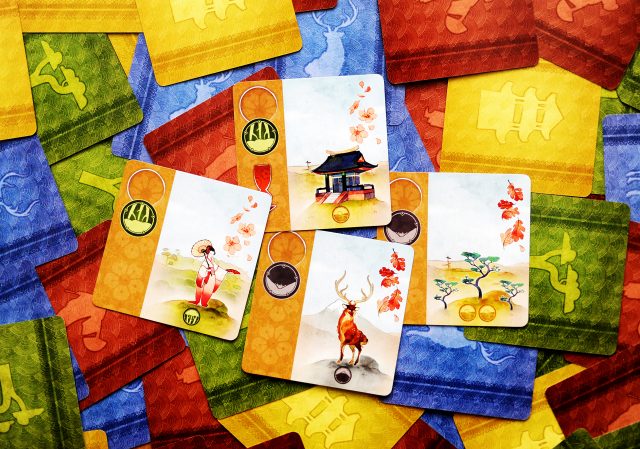 It’s not surprising that a game about learning the art of Japanese painting has some incredible art. In Kana Gawa players are students of Master Hokusai, the ‘crazy old artist.’ Over the course of the game they will paint their own masterpiece while expanding on their set of skills. As the paintings progress, players will work to complete sets of trees, buildings, portraits, and animals all while keeping track of the changing seasons. The art by Jade Mosch is like a beautiful, serene watercolour. At times you can see the brush strokes and imagine the quiet, peaceful setting where this work was created. Once the paintings are done there is a real sense of accomplishment for the created works. Incidentally, Kana Gawa could’ve also been mentioned in the components category, with its cute little paint brushes and bamboo board. All around a beautiful package for a great game.
It’s not surprising that a game about learning the art of Japanese painting has some incredible art. In Kana Gawa players are students of Master Hokusai, the ‘crazy old artist.’ Over the course of the game they will paint their own masterpiece while expanding on their set of skills. As the paintings progress, players will work to complete sets of trees, buildings, portraits, and animals all while keeping track of the changing seasons. The art by Jade Mosch is like a beautiful, serene watercolour. At times you can see the brush strokes and imagine the quiet, peaceful setting where this work was created. Once the paintings are done there is a real sense of accomplishment for the created works. Incidentally, Kana Gawa could’ve also been mentioned in the components category, with its cute little paint brushes and bamboo board. All around a beautiful package for a great game.
Lotus
There were very few games this year that were as immediately eye catching as Lotus. The theme is based around 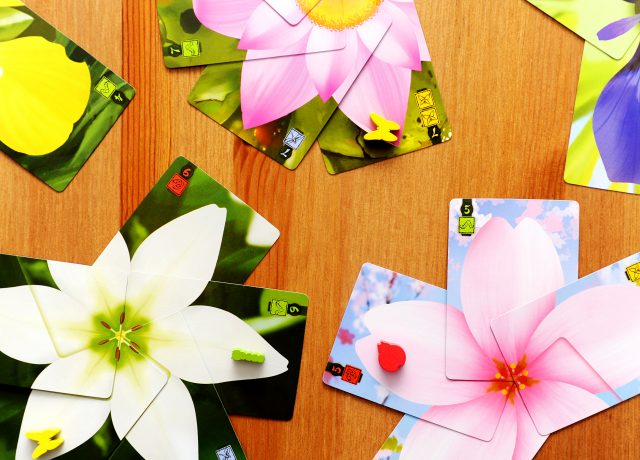 growing different types of flowers in an enchanted garden to gain eternal life. Everything, from the box art, to the flower petal cards that you’ll combine together to form completed flowers, to the special power tokens are imbued with a magical beauty. Chris Ostrowski’s work is breathtaking and the fact that is comes together in a really fun to play game, makes the combination that much better. Turn by turn, players will add to the flowers growing in the mystical garden or deploy their little insect Guardians onto incomplete flowers to increase their influence over them. Lotus is a game that promises beauty from the outset and delivers. Throughout the course of the game, the garden will take shape and your table will be converted into a beautiful botanical world. Simple to learn and highly re-playable, Lotus is simply lovely.
growing different types of flowers in an enchanted garden to gain eternal life. Everything, from the box art, to the flower petal cards that you’ll combine together to form completed flowers, to the special power tokens are imbued with a magical beauty. Chris Ostrowski’s work is breathtaking and the fact that is comes together in a really fun to play game, makes the combination that much better. Turn by turn, players will add to the flowers growing in the mystical garden or deploy their little insect Guardians onto incomplete flowers to increase their influence over them. Lotus is a game that promises beauty from the outset and delivers. Throughout the course of the game, the garden will take shape and your table will be converted into a beautiful botanical world. Simple to learn and highly re-playable, Lotus is simply lovely.
Covert
Covert is a super interesting spy game set in during the height of 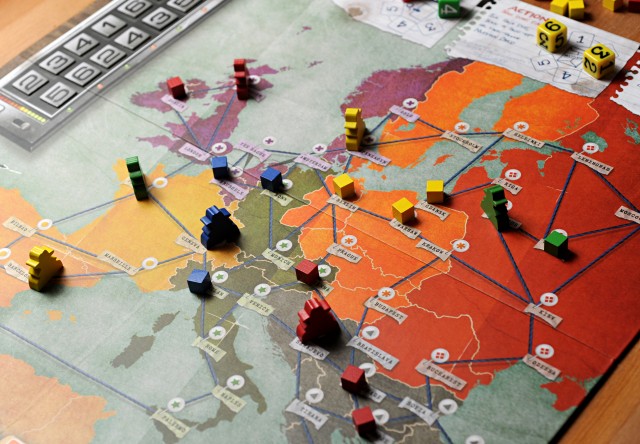 the Cold War and the beautiful art from the box cover on down give Chris Ostrowski his second appearance on this list. Players move around Europe from location to location pinned on the map with little scraps of paper. The cities are connected with string making the entire board look like it was hanging on the wall in some smoke-filled 1960s war room, with government agents in white shirts with their sleeves rolled up, trying to find some way to get behind the Iron Curtain. Players collect intel and equipment in the form of cool spy gear and complete missions once they have the necessary stuff. Actions are taking by rolling dice and placing them on the action spaces, and even those look like they’ve been hastily drawn on scraps of lined paper. It all comes together to create the perfect feeling of a certain time and place in our history. Sometimes creating something new is pretty tough, but it can be equally challenging to recreate imagery from a specific time and place. Covert manages to do this perfectly.
the Cold War and the beautiful art from the box cover on down give Chris Ostrowski his second appearance on this list. Players move around Europe from location to location pinned on the map with little scraps of paper. The cities are connected with string making the entire board look like it was hanging on the wall in some smoke-filled 1960s war room, with government agents in white shirts with their sleeves rolled up, trying to find some way to get behind the Iron Curtain. Players collect intel and equipment in the form of cool spy gear and complete missions once they have the necessary stuff. Actions are taking by rolling dice and placing them on the action spaces, and even those look like they’ve been hastily drawn on scraps of lined paper. It all comes together to create the perfect feeling of a certain time and place in our history. Sometimes creating something new is pretty tough, but it can be equally challenging to recreate imagery from a specific time and place. Covert manages to do this perfectly.
The Networks
 Good art should make you feel emotions and the art in The Networks makes us pretty consistently happy. The Networks is Gil Hova’s brilliant game that puts you in charge of a TV station and allows you to set the broadcast schedule, sell ad time, and hire the stars of your shows. It’s super simple in the rules department, but what really engages people is the incredible sense of humour displayed in the art on the cards. The shows are especially creative and fun to look at like Most Charismatic Explosions, Paisley is the New Burnt Umber, and How I Left Your Father. Travis Kinchy has done a wonderful job parodying popular shows and creating some new ones that we would love to watch. The Networks is a fun game to play and a huge part of that is the art.
Good art should make you feel emotions and the art in The Networks makes us pretty consistently happy. The Networks is Gil Hova’s brilliant game that puts you in charge of a TV station and allows you to set the broadcast schedule, sell ad time, and hire the stars of your shows. It’s super simple in the rules department, but what really engages people is the incredible sense of humour displayed in the art on the cards. The shows are especially creative and fun to look at like Most Charismatic Explosions, Paisley is the New Burnt Umber, and How I Left Your Father. Travis Kinchy has done a wonderful job parodying popular shows and creating some new ones that we would love to watch. The Networks is a fun game to play and a huge part of that is the art.
Unfair
Unfair is a game with a great sense of humour. The idea is that you’re building the most interesting and attractive theme 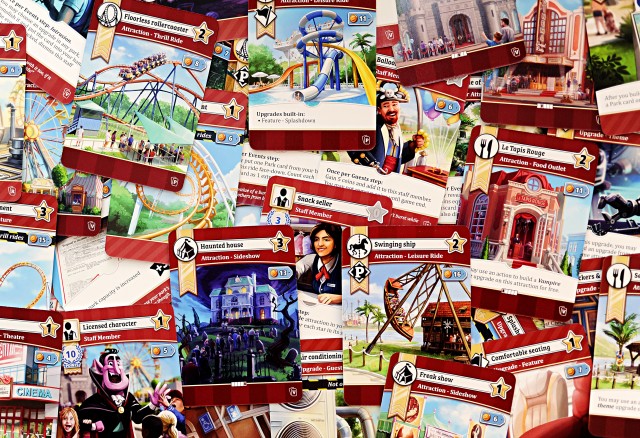 park in an effort to attract customers. At the same time, you’re trying to tear down the competition, by ordering surprise inspections and stealing their employees. The game is mostly card based, with different theme packs making up the main deck. The base set includes Vampire, Robots, Jungle, and Pirate themes and those come through in the type of rides and attractions that are available as well as the staff you might hire. Some of the park cards for panoramas when assembled in the right order and that’s just one of the many hidden Easter eggs you can find in the game. The Kickstarter campaign has unlocked a number of different new theme decks, such as the Ninjas and Gangsters there are limitless possibilities as to where the art can go. At the end of the game you will have built your own park and it may be filled with thrilling rollercoasters and waterslides or nothing more than theatres and restaurants. Either way, it’s going to look pretty!
park in an effort to attract customers. At the same time, you’re trying to tear down the competition, by ordering surprise inspections and stealing their employees. The game is mostly card based, with different theme packs making up the main deck. The base set includes Vampire, Robots, Jungle, and Pirate themes and those come through in the type of rides and attractions that are available as well as the staff you might hire. Some of the park cards for panoramas when assembled in the right order and that’s just one of the many hidden Easter eggs you can find in the game. The Kickstarter campaign has unlocked a number of different new theme decks, such as the Ninjas and Gangsters there are limitless possibilities as to where the art can go. At the end of the game you will have built your own park and it may be filled with thrilling rollercoasters and waterslides or nothing more than theatres and restaurants. Either way, it’s going to look pretty!
COMPONENTS
Potion Explosion
In Potion Explosion you’re playing students completing your final exams in potion class. The main mechanic of the 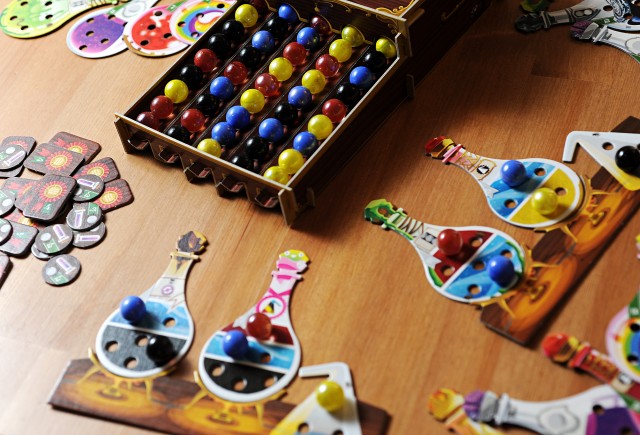 game is set collection, as you pull coloured ingredient baubles from the slide dispenser and add them to the potions you’re working on. The star of the game is that unique slide dispenser. There have been a few other games that have tried something similar, but never as successfully. The dispenser has several different angled columns that are filled with the glass ingredient marbles. When you pull out an ingredient, everything above slides down onto the marbles below, potentially causing an explosion. If two of the same ingredients smash together, an explosion occurs and you can take all of the touching marbles of the same colour. It’s a really simple idea, executed really well. The slide dispenser is a component that could easily not work well, but in Potion Explosion it’s perfect! The ingredients smash together with a satisfying crash and there is a wonderful endorphin rush when you manage to string together a big combination. Components don’t have to be crazy or high tech or revolutionary to be good. They just have to work well and incorporate the game play in an innovative way and the Potion Explosion slide dispenser definitely does that!
game is set collection, as you pull coloured ingredient baubles from the slide dispenser and add them to the potions you’re working on. The star of the game is that unique slide dispenser. There have been a few other games that have tried something similar, but never as successfully. The dispenser has several different angled columns that are filled with the glass ingredient marbles. When you pull out an ingredient, everything above slides down onto the marbles below, potentially causing an explosion. If two of the same ingredients smash together, an explosion occurs and you can take all of the touching marbles of the same colour. It’s a really simple idea, executed really well. The slide dispenser is a component that could easily not work well, but in Potion Explosion it’s perfect! The ingredients smash together with a satisfying crash and there is a wonderful endorphin rush when you manage to string together a big combination. Components don’t have to be crazy or high tech or revolutionary to be good. They just have to work well and incorporate the game play in an innovative way and the Potion Explosion slide dispenser definitely does that!
Mystic Vale
I loved the game Dominion and so will usually give a deck builder a shot, but even for me the mechanic has gotten a bit 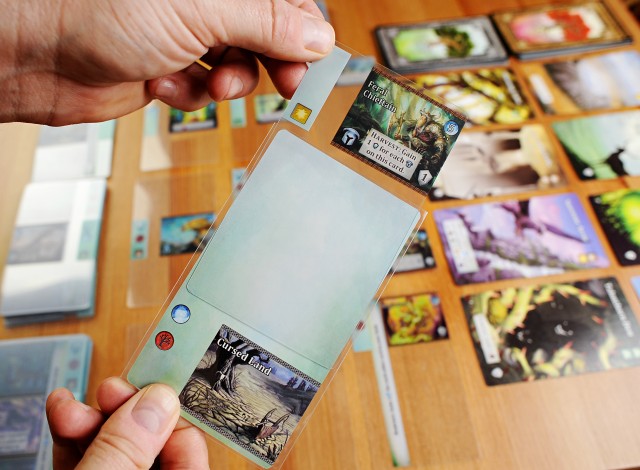 stale. That’s one of the reasons I was super pumped to play Mystic Vale. It isn’t really a deck builder, it’s a card crafting system, where your deck never actually gains cards, but the cards you do have become much more powerful. Using card sleeves and transparent cards, you slide in upgrades to your cards making them better at acquiring new and more valuable cards. I enjoyed the base game, but I would say there is room for it to grow. More than anything, the interesting use of some not so new components put Mystic Vale on this list. The creation of a newish mechanic is the real achievement. The combination of sleeves and transparent cards is quite brilliant and has far reaching potential into the future. There is already an expansion, Vale of Magic and I’m quite eager to give that a shot. Mystic Vale took a mechanic that was starting to feel a bit played out and breathed new life into it. The components aren’t necessarily groundbreaking, but they work perfectly in this execution.
stale. That’s one of the reasons I was super pumped to play Mystic Vale. It isn’t really a deck builder, it’s a card crafting system, where your deck never actually gains cards, but the cards you do have become much more powerful. Using card sleeves and transparent cards, you slide in upgrades to your cards making them better at acquiring new and more valuable cards. I enjoyed the base game, but I would say there is room for it to grow. More than anything, the interesting use of some not so new components put Mystic Vale on this list. The creation of a newish mechanic is the real achievement. The combination of sleeves and transparent cards is quite brilliant and has far reaching potential into the future. There is already an expansion, Vale of Magic and I’m quite eager to give that a shot. Mystic Vale took a mechanic that was starting to feel a bit played out and breathed new life into it. The components aren’t necessarily groundbreaking, but they work perfectly in this execution.
The Others
No one does minis better than CMON. Whether they’re the cute, vicious heroes from Arcadia Quest, to the infected  walkers from Zombicide, to the corrupted acolytes of The Others, the detailed figures are always amazing. With The Others, they’re particularly cool as half the figures in the game are minions of one of the Seven Deadly Sins. They take on the appearance and abilities of that Sin and boy, do those minis deliver the goods. These are figures that will haunt your nightmares. The lesser minions of each Sin are gruesome, but the HUGE avatar of each one is a sight to behold. With such intricate detail, you will really feel like the fate of the world rests on defeating them. The F.A.I.T.H. team members that stand in the way of the Sins are pretty darn cool too. Aside from the team included in the base box, there a re a number of expansion F.A.I.T.H. members who can join the fray. The art in The Others is pretty darn sweet too. It’s hard to call such haunting imagery beautiful, but the work by a team of artists certainly paints an apocalyptic picture.
walkers from Zombicide, to the corrupted acolytes of The Others, the detailed figures are always amazing. With The Others, they’re particularly cool as half the figures in the game are minions of one of the Seven Deadly Sins. They take on the appearance and abilities of that Sin and boy, do those minis deliver the goods. These are figures that will haunt your nightmares. The lesser minions of each Sin are gruesome, but the HUGE avatar of each one is a sight to behold. With such intricate detail, you will really feel like the fate of the world rests on defeating them. The F.A.I.T.H. team members that stand in the way of the Sins are pretty darn cool too. Aside from the team included in the base box, there a re a number of expansion F.A.I.T.H. members who can join the fray. The art in The Others is pretty darn sweet too. It’s hard to call such haunting imagery beautiful, but the work by a team of artists certainly paints an apocalyptic picture.
Junk Art
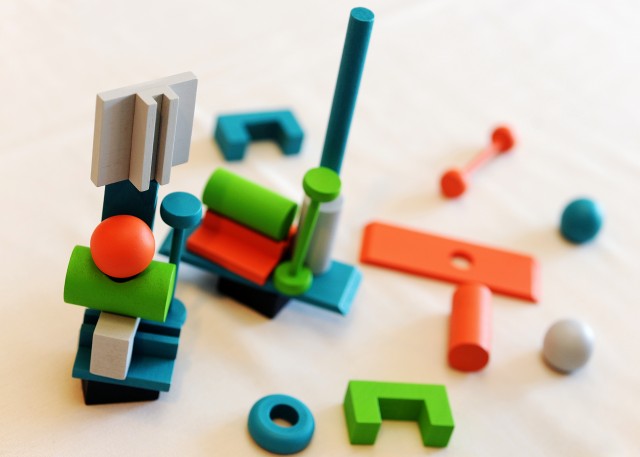 Pretzel Games produces extraordinarily beautiful products. Flick ‘Em Up is very cool dexterity game set in the old west. For their follow up they enlisted Jay and Sen, the Bamboozle Bros. to come up with a title that fits in their line perfectly. Junk Art is a dexterity game as well, but I’ve never really seen one like this. There are a number of different rule sets (all based on city names) that will force players to stack the intricate wooden pieces in four colours. Some of the rules will force you to stack as quickly as possible, others will make you incorporate strategy. Completing the package is the sweet wooden box with sliding lid that makes for a really nice visual on your game shelf. I’m not generally a fan of dexterity games, but the fine folks at Pretzel have intrigued me with their first two titles. Very much looking forward to where they go next and seeing them continue to produce highly playable games with amazing production.
Pretzel Games produces extraordinarily beautiful products. Flick ‘Em Up is very cool dexterity game set in the old west. For their follow up they enlisted Jay and Sen, the Bamboozle Bros. to come up with a title that fits in their line perfectly. Junk Art is a dexterity game as well, but I’ve never really seen one like this. There are a number of different rule sets (all based on city names) that will force players to stack the intricate wooden pieces in four colours. Some of the rules will force you to stack as quickly as possible, others will make you incorporate strategy. Completing the package is the sweet wooden box with sliding lid that makes for a really nice visual on your game shelf. I’m not generally a fan of dexterity games, but the fine folks at Pretzel have intrigued me with their first two titles. Very much looking forward to where they go next and seeing them continue to produce highly playable games with amazing production.
Knit Wit
Matt Leacock is known for his cooperative games, like Pandemic and Forbidden Island, but this year he came out with a 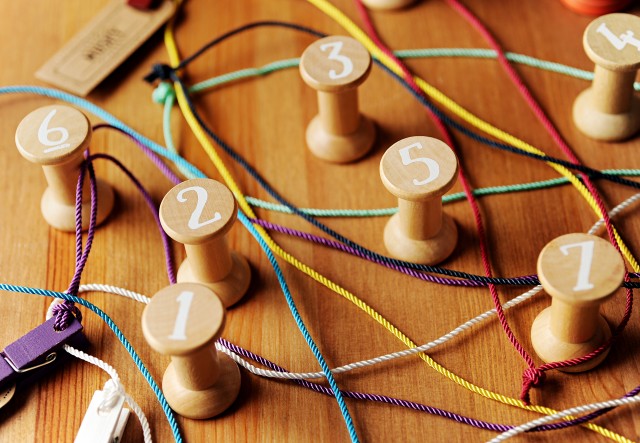 brilliant and beautiful party game. The idea of Knit Wit is that you’re adding different coloured loops of yarn with words attached to them and placing numbered spools into the loops. A spool may be surrounded by many different loops and so have multiple words associated with it. So, it your #4 spool is surrounded by loops with the words: Red, Flat, and Living, you have to find a word that fits all that criteria. Every part of the presentation of Knit Wit is brilliant. The spools and yarn are great, buttons that are awarded for finishing the round quicker work really well with the theme, even the answer sheets are more attractive than the typical white sheets of paper. Everything fits into the beautiful box perfectly making for a really nice presentation. For a game about knitting words together, Knit Wit sure has some nice bits.
brilliant and beautiful party game. The idea of Knit Wit is that you’re adding different coloured loops of yarn with words attached to them and placing numbered spools into the loops. A spool may be surrounded by many different loops and so have multiple words associated with it. So, it your #4 spool is surrounded by loops with the words: Red, Flat, and Living, you have to find a word that fits all that criteria. Every part of the presentation of Knit Wit is brilliant. The spools and yarn are great, buttons that are awarded for finishing the round quicker work really well with the theme, even the answer sheets are more attractive than the typical white sheets of paper. Everything fits into the beautiful box perfectly making for a really nice presentation. For a game about knitting words together, Knit Wit sure has some nice bits.
Comments
No comments yet! Be the first!